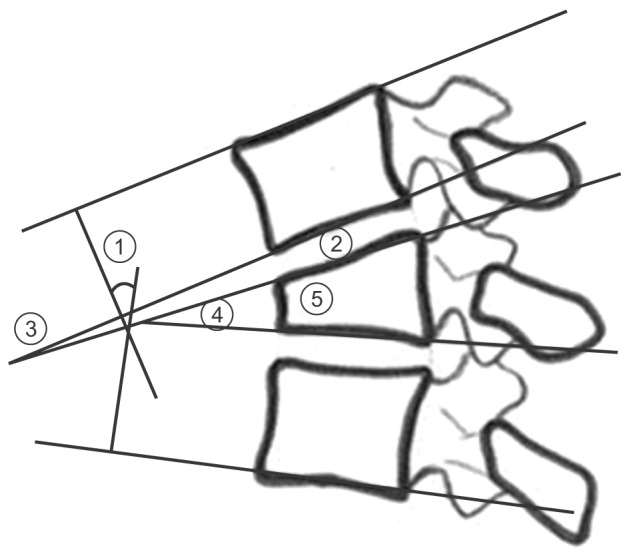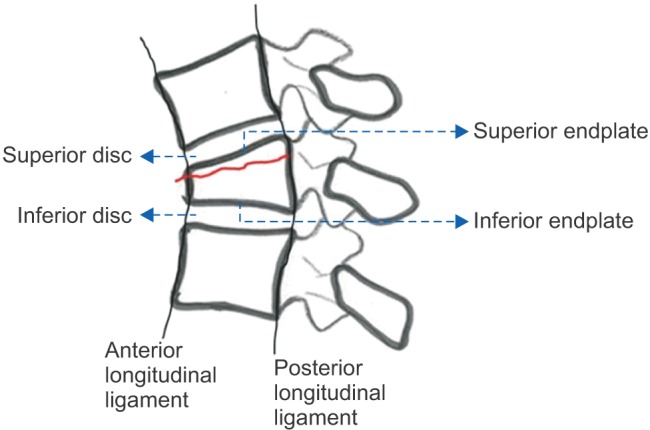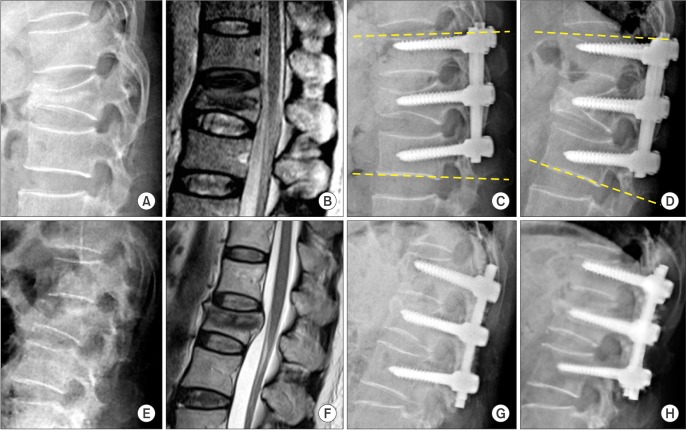Clin Orthop Surg.
2017 Dec;9(4):465-471. 10.4055/cios.2017.9.4.465.
The Relationship between Superior Disc-Endplate Complex Injury and Correction Loss in Young Adult Patients with Thoracolumbar Stable Burst Fracture
- Affiliations
-
- 1Department of Orthopedic Surgery, Dong-A University College of Medicine, Busan, Korea. drkimminwoo@naver.com
- KMID: 2412247
- DOI: http://doi.org/10.4055/cios.2017.9.4.465
Abstract
- BACKGROUND
To determine the relationship between superior disc-endplate complex injury and correction loss after surgery in a group of young adult patients with a stable thoracolumbar burst fracture.
METHODS
The study group was comprised of young adult patients who had undergone short-segment posterior fixation and bone grafting under the diagnosis of a stable thoracolumbar burst fracture from March 2008 to February 2014. Follow-up was available for more than 1 year. Before surgery, magnetic resonance imaging was performed to determine injury to the anterior longitudinal ligament, posterior longitudinal ligament, and superior and inferior intervertebral discs and endplates. Correction loss was evaluated by the Cobb angle, intervertebral disc height, upper intervertebral disc angle, vertebral wedge angle, and vertebral body height.
RESULTS
No significant relation was noted between correction loss and an injury to the anterior longitudinal ligament, posterior longitudinal ligament, inferior intervertebral disc/endplate, and fracture site, whereas an injury to the superior endplate alone and superior disc-endplate complex showed a significant association. Specifically, a superior intervertebral disc-endplate complex injury showed statistically significant relation to postoperative changes in Cobb angle (p = 0.026) and vertebral wedge angle (p = 0.047).
CONCLUSIONS
A superior intervertebral disc-endplate complex injury may have an influence on the prognosis after short-segment fixation in young adult patients with a stable thoracolumbar burst fracture.
MeSH Terms
-
Adult
Bone Transplantation
Female
Fracture Fixation, Internal
Humans
Intervertebral Disc/diagnostic imaging/*injuries
Longitudinal Ligaments/diagnostic imaging/*injuries
Lumbar Vertebrae/diagnostic imaging/injuries
Magnetic Resonance Imaging
Male
Prognosis
Spinal Fractures/*diagnostic imaging/*surgery
Thoracic Vertebrae/diagnostic imaging/injuries
Vertebroplasty
Young Adult
Figure
Reference
-
1. Dai LY, Yao WF, Cui YM, Zhou Q. Thoracolumbar fractures in patients with multiple injuries: diagnosis and treatment. A review of 147 cases. J Trauma. 2004; 56(2):348–355. PMID: 14960979.2. Gertzbein SD. Scoliosis Research Society: multicenter spine fracture study. Spine (Phila Pa 1976). 1992; 17(5):528–540. PMID: 1621152.3. McCormack T, Karaikovic E, Gaines RW. The load sharing classification of spine fractures. Spine (Phila Pa 1976). 1994; 19(15):1741–1744. PMID: 7973969.
Article4. Kaneda K, Taneichi H, Abumi K, Hashimoto T, Satoh S, Fujiya M. Anterior decompression and stabilization with the Kaneda device for thoracolumbar burst fractures associated with neurological deficits. J Bone Joint Surg Am. 1997; 79(1):69–83. PMID: 9010188.5. Katonis PG, Kontakis GM, Loupasis GA, Aligizakis AC, Christoforakis JI, Velivassakis EG. Treatment of unstable thoracolumbar and lumbar spine injuries using Cotrel-Dubousset instrumentation. Spine (Phila Pa 1976). 1999; 24(22):2352–2357. PMID: 10586460.
Article6. Shin TS, Kim HW, Park KS, Kim JM, Jung CK. Short-segment pedicle instrumentation of thoracolumbar burst-compression fractures: short term follow-up results. J Korean Neurosurg Soc. 2007; 42(4):265–270. PMID: 19096554.
Article7. Wang XY, Dai LY, Xu HZ, Chi YL. Kyphosis recurrence after posterior short-segment fixation in thoracolumbar burst fractures. J Neurosurg Spine. 2008; 8(3):246–254. PMID: 18312076.
Article8. Wang J, Zhou Y, Zhang ZF, Li CQ, Zheng WJ, Liu J. Radiological study on disc degeneration of thoracolumbar burst fractures treated by percutaneous pedicle screw fixation. Eur Spine J. 2013; 22(3):489–494. PMID: 22890568.
Article9. Jun DS, Shin WJ, An BK, Paik JW, Park MH. The relationship between the progression of kyphosis in stable thoracolumbar fractures and magnetic resonance imaging findings. Asian Spine J. 2015; 9(2):170–177. PMID: 25901226.
Article10. Kim HS, Kim SW, Ju CI, Lee SM, Shin H. Short segment fixation for thoracolumbar burst fracture accompanying osteopenia: a comparative study. J Korean Neurosurg Soc. 2013; 53(1):26–30. PMID: 23440679.11. Sapkas G, Kateros K, Papadakis SA, Brilakis E, Macheras G, Katonis P. Treatment of unstable thoracolumbar burst fractures by indirect reduction and posterior stabilization: short-segment versus long-segment stabilization. Open Orthop J. 2010; 4:7–13. PMID: 20177428.
Article12. Cinotti G, Della Rocca C, Romeo S, Vittur F, Toffanin R, Trasimeni G. Degenerative changes of porcine intervertebral disc induced by vertebral endplate injuries. Spine (Phila Pa 1976). 2005; 30(2):174–180. PMID: 15644752.
Article13. Kerttula LI, Serlo WS, Tervonen OA, Paakko EL, Vanharanta HV. Post-traumatic findings of the spine after earlier vertebral fracture in young patients: clinical and MRI study. Spine (Phila Pa 1976). 2000; 25(9):1104–1108. PMID: 10788855.14. Zhao FD, Pollintine P, Hole BD, Adams MA, Dolan P. Vertebral fractures usually affect the cranial endplate because it is thinner and supported by less-dense trabecular bone. Bone. 2009; 44(2):372–379. PMID: 19049912.
Article15. Urban JP, Smith S, Fairbank JC. Nutrition of the intervertebral disc. Spine (Phila Pa 1976). 2004; 29(23):2700–2709. PMID: 15564919.
Article16. Brickley-Parsons D, Glimcher MJ. Is the chemistry of collagen in intervertebral discs an expression of Wolff's Law? A study of the human lumbar spine. Spine (Phila Pa 1976. 1984; 9(2):148–163. PMID: 6729579.
Article17. Oner FC, van der Rijt RR, Ramos LM, Dhert WJ, Verbout AJ. Changes in the disc space after fractures of the thoracolumbar spine. J Bone Joint Surg Br. 1998; 80(5):833–839. PMID: 9768894.
Article18. Oner FC, van Gils AP, Faber JA, Dhert WJ, Verbout AJ. Some complications of common treatment schemes of thoracolumbar spine fractures can be predicted with magnetic resonance imaging: prospective study of 53 patients with 71 fractures. Spine (Phila Pa 1976). 2002; 27(6):629–636. PMID: 11884911.
- Full Text Links
- Actions
-
Cited
- CITED
-
- Close
- Share
- Similar articles
-
- MRI Findings of Posterior Ligament Complex Injury in Thorcolumbar Bursting Fractures
- Comparative Study of Radiologic Changes after Conservative Treatment in Compression fracture and Stable Bursting Fracture of Thoracolumbar Spine
- Comparison of the Extent of Degeneration among the Normal Disc, Immobilized Disc, and Immobilized Disc with an Endplate Fracture
- Relationship between the Progression of Kyphosis in Thoracolumbar Osteoporotic Vertebral Compression Fractures and Magnetic Resonance Imaging Findings
- Crush-Cleavage Fracture in Thoracolumbar and Lumbar Spine: Comparative Study with Type B Burst Fracture




